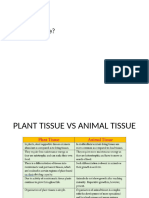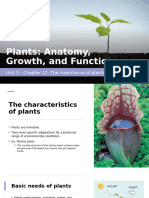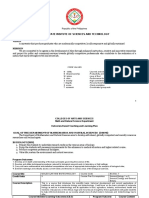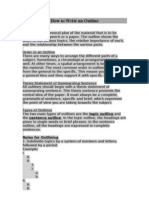0 ratings0% found this document useful (0 votes)
17 viewsBio 2
Bio 2
Uploaded by
Kyla Jane GabicaPlant organs are composed of three tissue systems - dermal, ground, and vascular tissues. Dermal tissue covers the outside and protects the plant. Ground tissue provides support and stores materials. Vascular tissue transports water, minerals, and compounds through two networks - xylem and phloem. Xylem transports water and minerals upward while phloem transports photosynthetic products throughout the plant. Leaves absorb light and carry out photosynthesis, with structures like the blade and stomata that regulate gas exchange.
Copyright:
© All Rights Reserved
Available Formats
Download as PDF, TXT or read online from Scribd
Bio 2
Bio 2
Uploaded by
Kyla Jane Gabica0 ratings0% found this document useful (0 votes)
17 views3 pagesPlant organs are composed of three tissue systems - dermal, ground, and vascular tissues. Dermal tissue covers the outside and protects the plant. Ground tissue provides support and stores materials. Vascular tissue transports water, minerals, and compounds through two networks - xylem and phloem. Xylem transports water and minerals upward while phloem transports photosynthetic products throughout the plant. Leaves absorb light and carry out photosynthesis, with structures like the blade and stomata that regulate gas exchange.
Original Title
BIO 2 - Google Docs
Copyright
© © All Rights Reserved
Available Formats
PDF, TXT or read online from Scribd
Share this document
Did you find this document useful?
Is this content inappropriate?
Plant organs are composed of three tissue systems - dermal, ground, and vascular tissues. Dermal tissue covers the outside and protects the plant. Ground tissue provides support and stores materials. Vascular tissue transports water, minerals, and compounds through two networks - xylem and phloem. Xylem transports water and minerals upward while phloem transports photosynthetic products throughout the plant. Leaves absorb light and carry out photosynthesis, with structures like the blade and stomata that regulate gas exchange.
Copyright:
© All Rights Reserved
Available Formats
Download as PDF, TXT or read online from Scribd
Download as pdf or txt
0 ratings0% found this document useful (0 votes)
17 views3 pagesBio 2
Bio 2
Uploaded by
Kyla Jane GabicaPlant organs are composed of three tissue systems - dermal, ground, and vascular tissues. Dermal tissue covers the outside and protects the plant. Ground tissue provides support and stores materials. Vascular tissue transports water, minerals, and compounds through two networks - xylem and phloem. Xylem transports water and minerals upward while phloem transports photosynthetic products throughout the plant. Leaves absorb light and carry out photosynthesis, with structures like the blade and stomata that regulate gas exchange.
Copyright:
© All Rights Reserved
Available Formats
Download as PDF, TXT or read online from Scribd
Download as pdf or txt
You are on page 1of 3
PLANTS’ SPECIALIZED STRUCTURES
• Plant organs are made of three tissue systems.
1. Dermal tissue covers the outside of a plant.
– protects the plant
– secretes cuticle of leaves
– forms outer bark of trees
VOCABULARY Made of Epidermis and Cuticle
Histology •Epidermis
•study of animal and plant tissues. - a protective tissue that covers the entire surface of the
plant. The epidermis protects the plant from infection and
Microtome water loss.
• an instrument used to cut tissues into
ultrathin sections. •Cuticle
– the outermost layer of plants, which covers leaves, fruits,
flowers, and non-woody stems of higher plants. It helps to
prevent evaporation from the leaf surface.
2. Ground tissue is found inside a plant.
– provides support
– stores materials in roots and stems.
– most commonly made of parenchyma.
3. Vascular tissue transports water, minerals and organic
Plant Cells and Tissues
compounds.
KEY CONCEPT
– two networks of hollow tubes.
● Plants have specialized cells and tissue systems.
– xylem transports water and minerals.
– phloem transports photosynthetic products.
• Water and dissolved minerals move through xylem.
* Xylem contains specialized cells.
– vessel elements are short and wide
– tracheid cells are long and narrow
– xylem cells die at maturity
• Phloem carries sugars from photosynthesis
throughout the plant.
* Phloem contains specialized cells.
– sieve tube elements have holes at ends.
– companion cells help sieve tube elements.
– unlike xylem, phloem tissue is alive.
• Transpiration is the loss of water vapor through leaves.
– water vapor exits leaf stomata.
– helps pull water to the top branches.
• Roots anchor plants and absorb mineral nutrients from
soil.
• Roots provide many functions.
– support the plant
– absorb, transport, and store nutrients
– root hairs help absorption
•There are several parts of a root.
– root cap covers the tip
– apical meristem is an area of growth
– vascular cylinder contains xylem and phloem.
KEY CONCEPT
● Leaves absorb light and carry out photosynthesis.
• Most leaves share some similar structures.
*The blade is usually broad and flat.
– collects sunlight for photosynthesis.
– connects to the stem by a petiole.
• Guard cells surround each stoma.
– Stomata open and close when guard cells
change shape.
– When stomata are open, water evaporates
and gas exchanges.
– Stomata close at night and when plant loses
too much water.
You might also like
- Meredith Shirk, CPT, WLS, BCS, FNSDocument27 pagesMeredith Shirk, CPT, WLS, BCS, FNSfisieresalvate100% (24)
- Airbnb EBOOKDocument29 pagesAirbnb EBOOKoliviaNo ratings yet
- Theories of The Origin of Solar SystemDocument18 pagesTheories of The Origin of Solar SystemGWYNETH REIN CARI�ONo ratings yet
- GENBIO Rev L6Document9 pagesGENBIO Rev L6pardosilangmNo ratings yet
- Plants Specialized StructuresDocument38 pagesPlants Specialized StructuresKyla Jane GabicaNo ratings yet
- ELSC Week13 Plant Survival PDFDocument43 pagesELSC Week13 Plant Survival PDFarriane BaladadNo ratings yet
- Plants Specialized StructuresDocument38 pagesPlants Specialized StructuresKyla Jane GabicaNo ratings yet
- Tissues 9thDocument31 pagesTissues 9thparinacool0710No ratings yet
- Leaf StructureDocument10 pagesLeaf StructureKristina PonceNo ratings yet
- Leaf StructureDocument10 pagesLeaf StructureMeanNo ratings yet
- Plant Form and FunctionsDocument2 pagesPlant Form and FunctionsJason TaburnalNo ratings yet
- Leaf StructureDocument10 pagesLeaf StructuregaliluserxaxaNo ratings yet
- 21 Plant Structure and FunctionDocument50 pages21 Plant Structure and FunctionRoan James OcampoNo ratings yet
- Leaf StructureDocument10 pagesLeaf StructureAya SobhyNo ratings yet
- TissuesDocument32 pagesTissuesspandeu37No ratings yet
- Plant Structure FunctionDocument58 pagesPlant Structure Functionno siNo ratings yet
- Plant Form Function ReproductionDocument60 pagesPlant Form Function ReproductionJanna AguilaNo ratings yet
- Raja Park, Jaipur Presentation Topic - Root DevelopmentDocument20 pagesRaja Park, Jaipur Presentation Topic - Root DevelopmentKhushbu ChoudharyNo ratings yet
- Plant Structure, Growth, & Development Plant Structure, Growth, & DevelopmentDocument74 pagesPlant Structure, Growth, & Development Plant Structure, Growth, & DevelopmentSophia AbatayNo ratings yet
- Biology Plant Based PresentationDocument86 pagesBiology Plant Based PresentationImCubanBeNo ratings yet
- The Plant Tissues.Document41 pagesThe Plant Tissues.JenniferNo ratings yet
- Absorption and Translocation in PlantsDocument39 pagesAbsorption and Translocation in PlantsChelsie Fae SantosNo ratings yet
- 21 Plant Structure and Function - 032212Document45 pages21 Plant Structure and Function - 032212Nudiya SappalNo ratings yet
- Meristematic Tis: Plants AnimalsDocument6 pagesMeristematic Tis: Plants AnimalsRajat ChauhanNo ratings yet
- PlanttissuesDocument25 pagesPlanttissuesphuongchi53100% (1)
- General Biology 2Document10 pagesGeneral Biology 2kristineNo ratings yet
- Plant Tissues EDITEDDocument44 pagesPlant Tissues EDITEDJonoel TaborNo ratings yet
- Genbio Long Quiz 2 ReviewerDocument42 pagesGenbio Long Quiz 2 ReviewerEthan Erika BionaNo ratings yet
- 7 Transport in PlantsDocument7 pages7 Transport in PlantsTina EtoileNo ratings yet
- Plant TissuesDocument33 pagesPlant Tissuesrupalidhir001984No ratings yet
- Plant Tissues Important Notes Class 9Document5 pagesPlant Tissues Important Notes Class 9vanukamesh2011No ratings yet
- Plant TissuesDocument32 pagesPlant TissuesVikneswaran Gunahlan Nesh100% (2)
- Leaves:: Form and StructureDocument37 pagesLeaves:: Form and StructureJane ManalusNo ratings yet
- PMA LeavesDocument37 pagesPMA Leavesalaiza.reblandoNo ratings yet
- #3 MRQ Lect - Botany Basic Types TissuesDocument34 pages#3 MRQ Lect - Botany Basic Types TissueselNo ratings yet
- Plant Structure and FunctionDocument14 pagesPlant Structure and FunctionniloumyhoneybunchNo ratings yet
- BIOL223-Lab 10Document60 pagesBIOL223-Lab 10chicken friesNo ratings yet
- Plant Tissues 2Document43 pagesPlant Tissues 2Francis MacasioNo ratings yet
- Class 9 CH-6 TISSUE by Vsishnavi ChoudharyDocument48 pagesClass 9 CH-6 TISSUE by Vsishnavi Choudharyimnavi24No ratings yet
- TISSUES - Class Notes - SprintDocument40 pagesTISSUES - Class Notes - SprintMr Vinod yadavNo ratings yet
- Plants AY2023 Lecture NotesDocument43 pagesPlants AY2023 Lecture NotesJose Kim JayNo ratings yet
- TissuesDocument18 pagesTissuestanya chopraNo ratings yet
- Plant Nutrition-The External Features of A Leaf and adaptations-PPT12Document37 pagesPlant Nutrition-The External Features of A Leaf and adaptations-PPT12ahill17No ratings yet
- 35 Lecture Presentation 0Document76 pages35 Lecture Presentation 0Catherina PurbaNo ratings yet
- Mauseth Chapter 05 PDFDocument2 pagesMauseth Chapter 05 PDFCharlotte AmanteNo ratings yet
- GS BIO 206. Functional Organization in PlantsDocument9 pagesGS BIO 206. Functional Organization in PlantsChary Johanne MenesesNo ratings yet
- LeavesDocument30 pagesLeavesjada tuckerNo ratings yet
- USABO-Plant Structure Growth and DevelopmentDocument82 pagesUSABO-Plant Structure Growth and DevelopmentdarshanpandaNo ratings yet
- DAY4 Plant Structure and FunctionDocument47 pagesDAY4 Plant Structure and Functionleanmarieallare0126No ratings yet
- Plant TissueDocument8 pagesPlant TissueAlana DariesNo ratings yet
- F5 Bio CH1-5Document11 pagesF5 Bio CH1-5angziyi575No ratings yet
- Lecture 14 Plant Cell Wall 2019Document38 pagesLecture 14 Plant Cell Wall 2019jeozbapqfpugltpsrbNo ratings yet
- Miedy Corazon Tabang Sta. Monica High School PhilippinesDocument68 pagesMiedy Corazon Tabang Sta. Monica High School PhilippinesArman Austria100% (1)
- Biology Term 3Document99 pagesBiology Term 3chipmunk 2024No ratings yet
- Chapter 5 Tissues and Primary Growth of StemsDocument47 pagesChapter 5 Tissues and Primary Growth of StemsJenilyn FarnacioNo ratings yet
- Plant Organs System: Roots & Stem Leaf Flower & FruitsDocument38 pagesPlant Organs System: Roots & Stem Leaf Flower & FruitsSweet EmmeNo ratings yet
- Report-Major 1 (Crop Science)Document29 pagesReport-Major 1 (Crop Science)Princess Rena RamosNo ratings yet
- L-6 Plant TissuesDocument34 pagesL-6 Plant TissuesIshita PandeyNo ratings yet
- Tissues, Roots, Stems, LeavesDocument128 pagesTissues, Roots, Stems, LeavesAlfonso Plantilla100% (2)
- Unit 5 Chapter 12 SBI3UDocument32 pagesUnit 5 Chapter 12 SBI3Uumniyah.najmuldeenNo ratings yet
- Bio 11 LE 2 ReviewerDocument2 pagesBio 11 LE 2 ReviewerLara GreyjoyNo ratings yet
- How Plants Grow - With Information on the Biology of Plant Cells, Roots, Leaves and FlowersFrom EverandHow Plants Grow - With Information on the Biology of Plant Cells, Roots, Leaves and FlowersNo ratings yet
- Theoreticalfoundationsofnursing 220509004803 5b2f38adDocument9 pagesTheoreticalfoundationsofnursing 220509004803 5b2f38adKyla Jane GabicaNo ratings yet
- GROUP 3 (Curriculum-Vitae) STEM BDocument22 pagesGROUP 3 (Curriculum-Vitae) STEM BKyla Jane GabicaNo ratings yet
- Reviewer in Entrep 2nd QuarterDocument5 pagesReviewer in Entrep 2nd QuarterKyla Jane GabicaNo ratings yet
- Group 9Document1 pageGroup 9Kyla Jane GabicaNo ratings yet
- 21 STDocument2 pages21 STKyla Jane GabicaNo ratings yet
- Waiting (21st)Document19 pagesWaiting (21st)Kyla Jane GabicaNo ratings yet
- PR (2nd)Document2 pagesPR (2nd)Kyla Jane GabicaNo ratings yet
- SACRA 1 ReviewerDocument2 pagesSACRA 1 ReviewerKyla Jane GabicaNo ratings yet
- OBE Syllabus in Molecular and BiotechnologyDocument13 pagesOBE Syllabus in Molecular and BiotechnologyYuri PaderesNo ratings yet
- Fish Fauna in Upper Dambovita River, RomaniaDocument10 pagesFish Fauna in Upper Dambovita River, RomaniaGrigore DavideanuNo ratings yet
- Solution Manual For Managing in A Global Economy Demystifying International Macroeconomics 2nd Edition Marthinsen 128505542X 9781285055428Document36 pagesSolution Manual For Managing in A Global Economy Demystifying International Macroeconomics 2nd Edition Marthinsen 128505542X 9781285055428daniellecolemizeadcokp100% (42)
- Elasticity: Chapter OutlineDocument37 pagesElasticity: Chapter OutlineLatifah NurhalizaNo ratings yet
- Foreign Exchange Dealers' Association of India: General Guidelines/InstructionsDocument18 pagesForeign Exchange Dealers' Association of India: General Guidelines/InstructionsSUVANKAR NANDINo ratings yet
- Age of Consent Sexual Intercourse With Young Persons and Access To Sexual and Reproductive Health Care in ZimbabweDocument42 pagesAge of Consent Sexual Intercourse With Young Persons and Access To Sexual and Reproductive Health Care in ZimbabweEmmanuel SibandaNo ratings yet
- Three BricklayersDocument2 pagesThree BricklayersBrylle Deeiah TumarongNo ratings yet
- MSRP-K 05Document274 pagesMSRP-K 05Francisco ReyesNo ratings yet
- Terms of Reference MFADocument2 pagesTerms of Reference MFAKEEVINNo ratings yet
- Francesca Stavrakopoulou - King Manasseh and Child Sacrifice - Biblical Distortions of Historical Realities-De Gruyter (2012)Document421 pagesFrancesca Stavrakopoulou - King Manasseh and Child Sacrifice - Biblical Distortions of Historical Realities-De Gruyter (2012)JuanNo ratings yet
- Latin American Political Thought - JOHN D. MARTZDocument22 pagesLatin American Political Thought - JOHN D. MARTZMadalina ChitacNo ratings yet
- Section 5Document16 pagesSection 5ssmileNo ratings yet
- Rational Expressions - Assignment BookletDocument44 pagesRational Expressions - Assignment BookletRand AhmadNo ratings yet
- House Talk Journey 2024 by HDCL Advisory (Johor) Registrant Kit Collective Sessions - Genting Property SDN BHDDocument19 pagesHouse Talk Journey 2024 by HDCL Advisory (Johor) Registrant Kit Collective Sessions - Genting Property SDN BHDPH LeeNo ratings yet
- Brian Eno On Music That Thinks For ItselfDocument4 pagesBrian Eno On Music That Thinks For ItselfMatia CamporaNo ratings yet
- Drug Study - ParacetamolDocument2 pagesDrug Study - ParacetamolNE TdrNo ratings yet
- How To Write An OutlineDocument3 pagesHow To Write An OutlinejenifresNo ratings yet
- Gospel Project Unit 2 Session 6 Persona Lstudy Guide - FallDocument12 pagesGospel Project Unit 2 Session 6 Persona Lstudy Guide - FallTodd GreenleeNo ratings yet
- Module-7-Tourism-and-hospitality-the-products-and-markets-context. 2Document13 pagesModule-7-Tourism-and-hospitality-the-products-and-markets-context. 2ericaluzande26No ratings yet
- La1353ec 7J419-69156Document38 pagesLa1353ec 7J419-69156Juan CarlosNo ratings yet
- Offer: The Offer Is The First Part of A ContractDocument4 pagesOffer: The Offer Is The First Part of A ContractSmita AcharyaNo ratings yet
- Answer The Following Questions: Question One:: Managerial AccountingDocument3 pagesAnswer The Following Questions: Question One:: Managerial AccountingMohammed QatariNo ratings yet
- DisciplinesDocument43 pagesDisciplinesKevin Russell50% (2)
- Google Search Operators - The Complete List (42 Advanced Operators) PDFDocument49 pagesGoogle Search Operators - The Complete List (42 Advanced Operators) PDFPradeep MagudeswaranNo ratings yet
- Labor ProductivityDocument18 pagesLabor ProductivityDave Bryan Torillo100% (1)
- T.T.D. Religious Publications Series No. 1103 PriceDocument32 pagesT.T.D. Religious Publications Series No. 1103 PriceklllllllaNo ratings yet
- Test 3 - 10 Grade - Why Go To SchoolDocument2 pagesTest 3 - 10 Grade - Why Go To Schoolaz0969962121No ratings yet
- Assignment:2 - AML 169 - Engineering Mechanics (B Arch) : Submit in A4 SheetsDocument3 pagesAssignment:2 - AML 169 - Engineering Mechanics (B Arch) : Submit in A4 SheetsKartik MauryaNo ratings yet

































































































